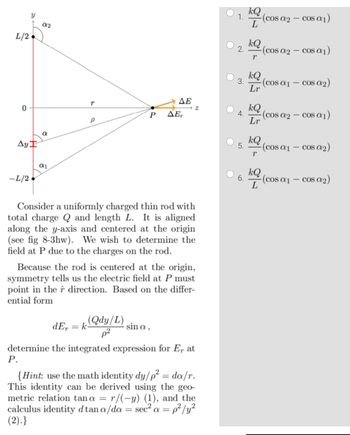Question

Transcribed Image Text:L/2
0
Ay
-L/2.
02
a
α1
T
ΔΕ
P ΔΕ,
(Qdy/L)
Consider a uniformly charged thin rod with
total charge Q and length L. It is aligned
along the y-axis and centered at the origin
(see fig 8-3hw). We wish to determine the
field at P due to the charges on the rod.
2
Because the rod is centered at the origin,
symmetry tells us the electric field at P must
point in the direction. Based on the differ-
ential form
sin a,
dE,= k
determine the integrated expression for E, at
P.
{Hint: use the math identity dy/p² = da/r.
This identity can be derived using the geo-
metric relation tana = r/(-y) (1), and the
calculus identity dtan a/da = sec² a = p²/y²
(2).}
1.
2.
kQ
L
5.
-(cos a2 - cos α₁)
6.
kQ
r
kQ
3. (cos α₁ - cos a₂)
Lr
-(cosa 2 - cos α₁)
kQ
4. -(cos a2 - cos α₁)
Lr
kQ
r
kQ
L
(cosa₁ - cos a₂)
(cos α₁ - cos a₂)
Expert Solution
arrow_forward
Step 1: Introduction
Introduction:- When the rod has a charge on the rod it shows an attractive or repulsive nature to another object.
Given:- Uniformly charged thin rod with length and total charge.
To determine:- The electric field at point
Step by stepSolved in 3 steps with 9 images

Knowledge Booster
Similar questions
- Percent of Intervals 100 Baseline 90 80 70 60 50 40 30 Tootling Intervention Tootling Withdrawal Tootling M 20 1 10 0 1 2 3 4 5 6 7 8 9 10 11 12 13 Days 14 15 16 17 18 19 20 Classroom 1: Ms. Doran Compare data across adjacent conditions. Select all that apply. From A1 to B1, there was a change in: level ☐ trend variability Cannot tell with the information providedarrow_forwardW NWP Assessment Builder Ul App x wwNWP Assessment Player Ul Appli X b Home | bartleby education.wiley.com/was/ui/v2/assessment-player/index.html?launchid=03be40d5-94c7-456c-a175-078cbc7944fc#/question/23 ← → C Help Centre a myMapúa: Welcome Microsoft Office Ho... Courses Microsoft Teams - L...Mail-ALLYSON VIV... ParentPortal | Mapu... Current Attempt in Progress ● WP R(smaller) = i R(larger) = i Save for Later 34°C Sunny - = Units Units Q Search x + Two resistors have resistances R(smaller) and R(larger), where R(smaller) < R(larger). When the resistors are connected in series to a 12.0-V battery, the current from the battery is 1.33 A. When the resistors are connected in parallel to the battery, the total current from the battery is 9.04 A. Determine the two resistances. V ParentPortal | Mapu... MathWorks - Make.. ps Turning Point - Parti.... a 12 Explore GitHub ☆ * ENG US 0 X D ⠀ 33 Attempts: 0 of 3 used Submit Answer 2:27 pm 18/03/2023arrow_forwardTAKE, Part 2 Mod 4 Test RETAKE, Part 2-Goo X a docs.google.com/document/d/1 0UmbwLYkGCDZHIkgxzwpQQ7vjccTpdDTnnanlrdoco/edit SRSD Bookmarks SRintranet R AR BookFinder US G South Redford Sch.. Google Slides Ms. Denton ELA M Ms. Denton's Websi... A Social Studies Bon. Mod 4 Test RETAKE, Part 2 ☆ D A File Edit View Insert Format Tools Add-ons Help Last edit was 5 minutes ago 2 ē Ą P 100% в IUA - E-| 1 | E - E - E E x ** Normal text | Arial 12 3 1.4 171 8. 目 2. Which of the following FBD's (Free-Body Diagrams) is most likely to represent an object that is accelerating upward? 4"十,十,十 (A) (B) (C) (D) Best answer: Explain your reasoning: 3. Using the same four FBD choices shown in the previous problem, which is most likely to be an object with zero net force acting on it? Best answer: Explain your reasoning: 4. You are looking at some new FBD. You determine from it that there IS a (non-zero) net forcearrow_forward
- Suppose the point of insertion of the biceps muscle into the lower arm shown in (Figure 1) is 6.0 cm. Part A How much mass could the person hold with a muscle exertion of 530 N? Express your answer to two significant figures and include the appropriate units. for Part A for Part Vndo for Par redo for Part A reset for Part A keyboard shortcuts for Part A help for Part A kg m= 2.94 Submit Previous Answers Request Answerarrow_forward3. Aperson tries a new diet where they eat only eggs as their protein source. They lost 1.7 19ina weelkHow many micrograms/second did the gperson lose on average 4) 2.8x10°micrograms/s. B,47 micro gram/s. C)6.8x10micrograma/s D/27x10°miccogramsb 2コ×10iccogcarosarrow_forwardI requested to you please solve all mcqs with ßolutions i requested to u solve all handwriting please THANKS ?arrow_forward
arrow_back_ios
arrow_forward_ios